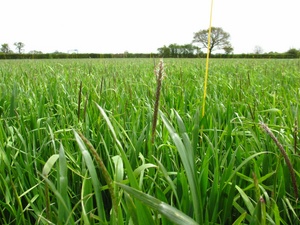I read recently, possibly in the Farmer’s Weekly, that a Scottish farmer said their Independence Referendum is a choice between hope and fear. Thinking about it, I suppose it was always going to be so. The ‘yes’ campaign is bound to be espousing their hopes for an independent Scotland and the ‘no’ campaign is bound to be expressing their fears. The art is to try to identify whether the hopes and fears expressed are realistic or unrealistic.
There are choices between hopes and fears to be made in arable agriculture, particularly at a time when market prices are less than the cost of production. As an aside, I am slightly amused that I have yet to hear from a farmer who has not sold a substantial proportion of this year’s cereal harvest a few months ago when market prices were considerably higher!
I am sorry to fall on familiar territory but many farmers’ approaches to black-grass control over the last few years have been based more on unrealistic hope than realistic fear. I gave talks a few years ago where the farmer audience seemed hostile to my concerns over future control. There is no doubt that it is easier to ‘sell’ hope rather than fear.
I remember one particular meeting where farmers appeared to be convinced that more competitive varieties were the answer to the impending crisis. I explained that if such varieties behaved consistently in reducing black-grass seed shed by 25-50% then the herbicide control required in order to stand still in black-grass plant numbers was only reduced from 97% to 95-94%. It was clear that they did not want to believe me.
However, the maths of black-grass control only shows the huge challenge for cultural control. By the way, varieties vary between years in their relative competiveness against black-grass; there is no consistency. Indeed, the lack of consistency of cultural measures is a major issue but it is clear that when you are in the mire with black-grass, increasing crop competitiveness is not sufficient alone to turn the tide. Perhaps the most consistent and effective cultural control measure is spring cropping but even then, in 2013, there was a huge black-grass emergence in some spring drilled crops.
There have been unrealistic fears expressed over the cultural control measures of ploughing and growing spring barley on heavy soils. The doubt expressed about ploughing is that it will destroy the soil structure built up over the years by non-inversion tillage to about 20cm depth. The evidence produced by NIAB TAG’s NAC STAR project, on medium clay in Suffolk, suggests that in crop yield terms this is not a concern.
The other fear is that it is impossible to establish consistently spring barley on heavy soils. As I said in my previous blog (Climate and rotation), this year was particularly challenging in this respect but the machinery now available is better able to establish great spring barley crops. I have to admit that spring cropping on heavy soils is always going to be more risky than early autumn drilling but the level of fear in some farmers’ eyes is perhaps too high.
Many farmers have now given up realistic hope of continuing with early drilled continuous autumn cropping established after non-inversion tillage. Personally I am convinced that to get to a more stable situation there is a need on many infested farms to reduce dramatically background black-grass populations by taking radical cultural control options rather than hoping to manage moderate populations from year to year. The realistic fear, even with a huge expenditure, is that chemical and cultural control measures will not be consistent from year to year and the economic consequences of a moderate population not being controlled are very significantly higher than a low population not being controlled. In addition, herbicides give higher levels of control of black-grass heads in low populations when compared to moderate populations.
So whilst we have to give up realistic hopes, at least over the next few years, of being able to control black-grass in rotations that consist only of early autumn drilled crops, perhaps the fears associated with some cultural control measures are unrealistically pessimistic.

